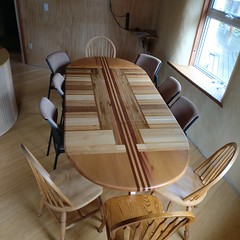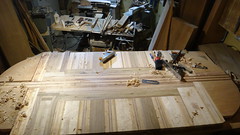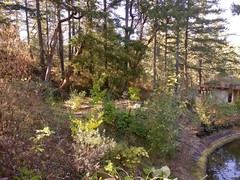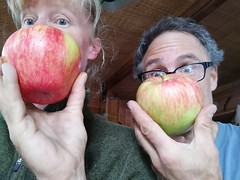Gord sees nuts of all kinds as an absolute must to meet the future food needs for our region, and therefore has spent a lot of time learning about Walnuts, Chestnuts, Hazelnuts, Pine Nuts, Yellowhorn, Caragana (Siberian Pea Shrub), Northern Pecan and almond, and getting them ready for sale right here in Victoria BC. Nuts are a long term staple that will be the replacement for the grains, and are healthier due to the rich proteins, nutrients, oils and complex carbs not present in the grains. Below is a listing of the nuts and seeds we sell.
Pine Nuts
Pine nuts are the seeds of the Pinus species, 20 of which produce large enough nuts to make humans different than squirrels in their harvesting practices (the latter being more patient and less lazy). We have learned that for pine nuts to thrive, a good quality mychorizal innoculant is required, combining beneficial bacteria and fungus so the roots develop and can absorb the correct nutrients. The best resources in learning about the Pinus species comes from Rhora’s Nut Farm and the Northern Nut Grower’s Association. Our innoculant we use is from Rhora’s.
To add to our fervour about increasing nuts and seeds regionally, the book Tree Crops: A Permanent Agriculture, 1953 edition, by J. Russell Smith, a book that was the pre-cursor to permaculture and a resource for Bill Mollison.
Siberian Stone pine – Pinus siberica
Trees are very ornamental in appearance having a very blue colour to the needles. Slow growing at first, but with inoculant they should be producing cones by 5 – 8 years.Mature height to 100 feet. Produces a very thin shell which can be cracked between the fingers. Will grow in a variety of soils from wet clay to Peat moss or sandy loam. Not self fertile… sold in pairs
More info from PFAF…
Swiss Pine – Pinus cembra
Very hardy tree reaching at maturity of 50-70 feet. Will withstand extreme weather conditions.
Potential commercial nut crop type tree. Grows in a clay type of soil with adequate moisture. In its native habitat, it grows in open areas on northern slopes in heavy clay. Although they grow in heavy clays, this will do equally as well in sandy to loam type of soil as well. Cones take three years to mature, but each year new cones are formed, insuring a continuous crop once they reach bearing age. Tree has a very attractive appearance, with a very blue colouring to the needles all year round. Trees produce cones at the age 12 years if inoculated, but normally it takes 14 -16 years. Not self-fertile… sold in pairs.
More info at PFAF…
Pinyon Pine – Pinus edulis
Beautiful blue colour. Drought tolerant pine native to the Rocky Mountains. Short trunk with spreading branches. Edible nuts. Grows to 50 ft, hardy to zone 5. Not self fertile… sold in pairs.
More info at PFAF…
Chestnuts – Castanea spp.
Chinese Chestnut – Castanea mollissima
A sweet edible chestnut growing 40 to 60 feet tall and wide. This versatile tree can grow in many types of soil, including dry, highly acidic and nutritionally poor, sandy soil or heavy clay. However it doesn’t tolerate alkaline soils. It does best when you plant it in deep, moist, well-drained, neutral to slightly acidic, loamy soil. The Chinese chestnut tree prefers full sun, but also grows in partial shade, and has a medium tolerance for mild sea spray if you live near the coast. It is resistant to chestnut blight – though blight is not of concern due to lower humidity in the summer which seems to control it.
Japanese Chestnut – Castanea crenata
A sweet edible chestnut on a tree that grows 30-40 ft tall and wide. It grows in moist, deep, well-drained loams in full sun. Tolerant of summer heat and humidity. Established trees do well in dry conditions. If growing this tree at least in part for its edible nuts, planting more than one tree facilitates cross-pollination and produces a much more abundant nut crop. It is resistant to chestnut blight and is used in hybridization to create stronger trees in North America.
American X Chinese Chestnut – Catanea dentata X Castanea mollissima
The American chestnut was virtually wiped out in the humid areas of the US due to chestnut blight. The trees are big at almost 100 ft tall, though the cross with chinese are smaller, and more blight resistant. The varieties we have were derived from a 6o year old grove in Langley, collected by Thom Odell of Nature Tech Nursery.
American Chestnut – Castanea dentata
The American chest was all but extinct due to chestnut blight. In an effort to extract every last bit of timber before they all died, all the healthy tress were cut down, ironically the healthy trees were likely blight tolerant thus almost exterminating the genetics. Luckily a few years back some trees were found, and since then some good quality nuts had been collected.
These trees grow to 100 feet, and can produce up to 1000lbs of nuts. A mainstay in the US, they are a great feedstock for humans and other farm animals alike. The wood is rot resistant and long lasting We have started 100 seedlings that should be ready for 2017.
Yellowhorn – Xanthoceras sorbifolium
Yellowhorn
A deciduous, leafy bush or small tree growing up to 5 m (22′-24′)tall and bearing reddish-brown branches. It grows well on rocky slopes on hillsides, and is drought tolerant. It prefers acidic dry soil and does not do well in hot wet locations. Hardy in Zones 4 to 7. It is drought tolerant and will survive temperatures below -20 °F. The flowers appear in May or June (before the leaves) in sprays up to 25 cm long. The fruit is a round or pear-shaped capsule up to 6 cm long, revealing a spongy, white inner surface when it splits into three sections to release the seeds, which are round, purplish-brown and edible.
Also referred to as Chinese Macadamia, it is cultivated In Northeastern China for it’s edible fruit, reminiscent of chestnuts, it has a seed pod several inches across that have a number of pea sized seeds. These seeds contain up to 70% oil. In cultivation, it can produce over 800 gallons of oil per acre.
The article that sold me was from Asian Agricultural Research, Afforestation Technique of Xanthoceras sorbifolia Bunge; XIANG Xiao-qin, LI Qiao-qin, LI Zhong-hong1, and LIU Guang-zhe.
More info can be found at PFAF…
Hazelnut – Corylus avellana
It took 7 years research to acquire the hazelnuts we wanted, as during this time shipments of most nuts and all hazelnuts had been banned into BC. The industry was crashing due to Eastern Filbert Blight. The best cultivars we could find were from the Oregon State University (OSU) Breeding Program. It was not until 2013 that we made a connection with Thom Odell, who had been at OSU during the breeding program, he had moved to BC and spent several years trying to get the OK to bring sterile plant tissue into BC for tissue culturing into trees. Today we can offer Thom’s trees.
Huge library of information from OSU on everything hazelnut…
Thom does sell to the public, but to make it easier on everyone, we have been purchasing his stock in quantity and bringing to the island, and working with people to help them choose a healthy mix.
Eco-Sense was experimenting – on whether the Hazelnuts were jug lone tolerant. We have learned since our first experiments, through Burnt Ridge nursery that C. Avellana is tolerant and thus will make a great addition to a walnut guild as we have done..
Recommended Mixes – we prefer to sell as a set of four (Jefferson, Theta, Yamhill and Gamma).
Nature Tech Nursery Planting Instructions
Following cultivars are from the Oregon State University Breeding program
Jefferson – EFB resistant
Smaller to medium sized tree that has upright structure, has high yield of medium sized nuts, and a long bloom period. Theta and Eta support the later portion of Jefferson’s bloom, having the most overlap, so these are the preferred pollinizer. Yamhill and Gamma overlaps the early/mid bloom. This is one that we use for a main cropper, and we build the supporting trees around this one.
Yamhill – EFB resistant
A small to medium sized tree with spreading structure that produces extreme quantities of smaller sized nuts. It is an early bloomer, so Gamma and Sacajawea are the best pollinizers. It is considered a good match to help pollinate the early portion of Jefferson’s bloom. This is also one of the trees we classify as a main cropper, and thus we work in supporting trees to help ensure good production.
Sacajawea – EFB marginally resistant
A medium upright and spreading tree, with smaller nuts similar to Yamhill, the earliest producer, yet with a mid season bloom time. It is actually a very high and highly efficient producer, a great support tree for Gamma and Yamhill, with benefits. Due to the allele patterns, we separate the Sacajawea from the Jefferson, by placing Gamma and Yamhill between them.
Gamma – EFB resistant
A small to medium height but vigourous and robust trunk, upright and spreading tree, with medium crop size of small nuts. It is early to bloom and supports Yamhill and Sacajawea.
Theta – EFB resistant
A smaller tree, with upright growth and vigorous robust trunk. Bloom is very late, not known as a heavy cropper nor has it high yields, but is the key pollinator for Jefferson, and thus we at least pair up all Jeffersons with a Theta.
Eta – EFB resistant
A small upright tree, that produces early moderate crops of small size nuts. Eta’s are late blooming, but not very late like Theta, and thus make a great secondary support tree for Jefferson.
Conventional cultivars found commonly within the region
Ennis
Large (largest) nut size, on a tree that is large and upright, moderately vigorous. A late season producer of heavy crops of large nuts. Butler has been a common pollinizer. Not EFB resistant.
Though we do have Ennis and Butler, we are not inclined to sell these unless asked.
Butler
Though we do have Ennis and Butler, we are not inclined to sell these unless asked.
Almond – Prunus spp.
Almonds are under the Prunus species, and come in a wide variety of forms. Prunus dulcis, Prunus tenella, exhibit different profiles. The common almonds (Prunus dulcis var. dulcis) is sweet. The Hall’s hardy almond (Prunus dulcis) is sometime found to be bitter and needs to have the cyanide soaked out and roasted – plants should be bought from suppliers that can ensure it is a sweet Hall’s Hardy. We have yet to find a supplier that has full confidence on this. Prunus tenella falls into the same category as the Hall’s, except for the fact that we have found a grower who has a sweet variety.
Our Almond list may grow over time as we keep searching and learning.
Russian Almond – Prunus tenella (sweet)
Extremely hardy, very ornamental shrubs. Those who always wanted to grow hardy almonds, this is a must for those in climatic zones which would not support the common almond. The grower, Rhora’s Nut Farm, has experimented for several years now and for the first time offer these to our customers. The fruit (drupes) is a little smaller than the commerical type. Their kernel has the same texture taste and the same nutritunal values. Has masses of of rose pink flowers in early spring, followed by the fruit.
Siberian Pea Shrub – Caragana arborescens
Siberian Pea Shrub
This was a tree that we looked long and hard at for over a year. It is a medium to fast growing perennial shrub to 12 feet, that is leguminous, handles drought, all soil types, is food for chickens and humans (has edible young pods and mature seeds), a nitrogen fixer, and a soil stabilizer for steep slopes. Considered one of the top plants for agroforestry by PFAF.
Sezchuan Pepper Tree- Zanthoxylum simulans
Sezchuan Pepper Tree
We like our pepper, and this seemed to fit our needs well, as it can grow in zone 6, in full shade, part shade, or full sun. It is widely documented as not being self fertile, yet the cultivars we have seen has shown otherwise, but we do recommend two seedlings , or rooted cuttings from different parent plants for best pollination. We have ours from two different sources and labelled as such to ensure mixing and matching.
More info at PFAF…
Walnuts – Juglans spp.
We are in the early stages of our walnut development. We have a variety that are growing here, the English Walnut, Black Walnut, Heartnut, and Butternut (and possibly a Buartnut). We are developing guilds around each of the trees, an interesting process as we are seeking a good mix of all layers that are jug lone tolerant, serving multiple purposes.
To see what we are mixing in with these trees, and to see in person what is working and what has failed, you’ll have to come see us. Spring 2014 is the planting out of the guilds… an exciting time. Not to leave you hanging about walnuts… here are links to information on the cultivars we have:
Japanese Heartnut – Juglan ailantolia var. Cordiforis
Very fast growing, hardy, tropical in appearance. The nuts hang in clusters, similar to grapes, with up to 20 nuts in a cluster. Usually grows wider than taller, but some varieties produce good timber type trees. Taste is mild, somewhat like the nut pines. The Heartnut is a cultivar of Japanese Walnut distinguished by its fruit, which is heart-shaped in cross section, easier to crack, and able to yield an unbroken nut meat when cracked. The Heartnut is a sweet nut without a bitter aftertaste often intrinsic with Black and Persian Walnuts.
Japanese Heartnut – Jugulans sieboldiana ‘Simcoe’
Similar to the Heartnut but more spherical nut.
Black Walnut – Juglans nigra
A North American native noted for its timber value, and good production of fine edible nuts. A big tree, but can be kept smaller via trimming wood for other uses.
Butternut – Juglan cinerea
The hardiest member of the walnut family, this tree will grow into a large tree at maturity. Noted for its light textured coloured wood. Produces large size nuts with a very distinct flavour. Grows in a wide variety of soils, and is also known for its sap drunk straight or boiled into a syrup.
Buartnut – J. Cinerea x J. ailantifolia
A cross between the Heartnut and Butternut, the Buartnut exhibits disease resistance, hybrid vigor, superior hardiness, and bears large crops. Plants For A Future has limited info on this, but here is the link to be consistent.
English Walnut (Persian or Carpathian walnut) – Juglans regia
A tree that can grow 60 feet tall and wide, in sun, which likes well drained soil. Info from PFAF…
Hardy Northern Pecan – Carya illinoinensis
We are experimenting with two hardy pecans (of the Hickory family). Large nut Hardy Sweet Pecan and the Hardy Sweet Campbell NC 4 from northern nut growers in Ontario. We were holding a “Wait and See” approach on how these seedlings took… they TOOK and by tears end of 2014 the plants we had expected to sell at three years of age were snapped up. We have planted more and may have some for 2015. Good for zones 5-8, long lived at 200 years, start producing nuts at 7-10 years, but should replace Gord’s broken handles much earlier.










Hi
Hope you had a good start to the year?
As I cannot buy trees from N.America I am looking for seeds if possible for zone +7. I am intrested in hardy N.pecan and most of what you have on your site..
Can you help?
Thanks
Greetings from Slovenija
Stewart
Hi Stewart, In Europe you might try B&T World seeds, based out of France. I have bought from them in the past and they are a good responsible supplier. Also if you search out Plants for a Future (PFAF) and do a database search for the plants you are interested in, they sometimes have a link as who supplies them in Europe. Otherwise Grimo’s Nut Nursery in Ontario Canada may be able to ship.